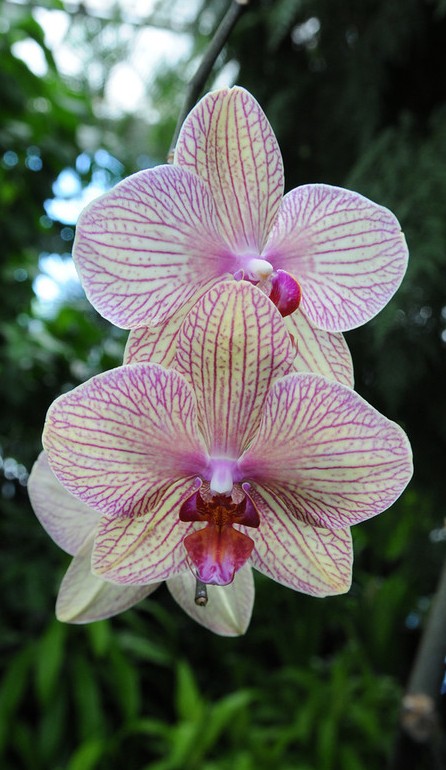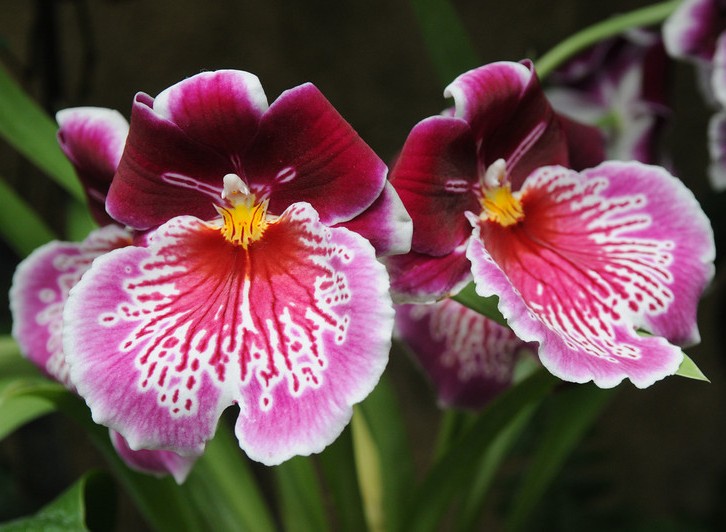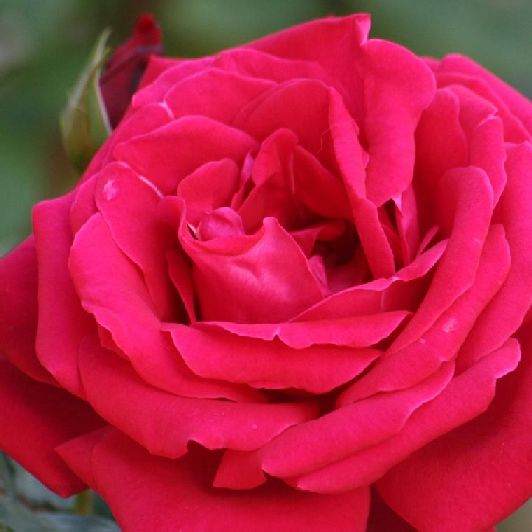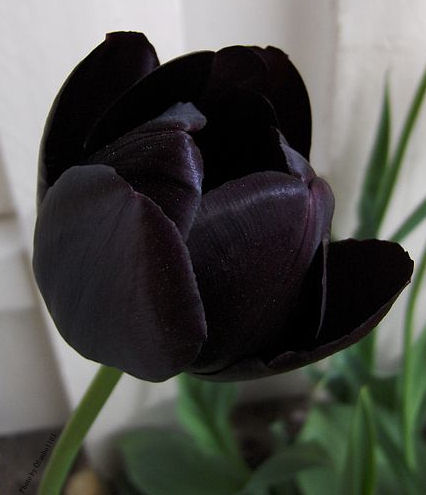The Rose: Splendor of Order with Poetry
The Orchid: Unexpected Beauty
The Tulip: Masterpiece of Coherence
(based on a talk by Prof. Plinio Corrêa de Oliveira – Saint of the Day, March 6, 1971)
Many years ago some Dutchmen managed to bring tulip bulbs to Brazil and to plant them, since here anything will grow…
Way back in the 16th century, when Pero Vaz de Caminha wrote King Dom Manuel of Portugal his first letter from Brazil – a long report in beautiful Portuguese describing the country – he had that famous phrase: “This land, Lord, is generous and bountiful, and anything you plant will grow” … And so did tulips as well. Now someone has asked me to make a little description of the tulip in line with our “Ambiences and Customs” section.
Rows and rows of tulips in the fields in South Holland.
Is the tulip the most beautiful of flowers? Not in my view. There are two flowers which I personally prefer to tulips.
The first, obviously, is the rose. Like it or not, an entirely beautiful, perfect and well-finished rose is a glory, a beauty, a marvel, an unequalled symbol of order. It occupies the top spot.
After the rose (and this is a personal opinion which I don’t think is shared by many) there is a flower that grows in Brazil in a marvelous way and I heard even more so in Colombia: the orchid, which has a type of beauty profoundly different from that of the rose.
The rose shows the splendor of order. It is eminently orderly, its petals are all placed in order and all its forms of beauty obey some reasoning. There is nothing planned in the rose. I would be far from making the horrible statement that the rose is all planned in advance. Yet one could say that it was indeed planned by a poet… God Our Lord planned it and determined its role. Everything about the rose is orderly, established, arranged. It has the perfume proper to its type of beauty and possesses the beauty of a pre-established, rational and explicit order. The rose is a wonderful explicitation of the concept of beauty!
If this is true of the rose, the opposite can be said of the orchid. The orchid is rare, unique and holds surprises in store. It has petals that move as it were in a ballet, in directions that no one imagines, and forms around a central axis that also varies from one type to another. The orchid’s central part always has a magnificent but unexpected beauty. For example, it is white on the edge and then red and a deep purple, all the way to a mysterious part inside where you have the impression there is a most sublime vermilion, which does not appear, due to a kind of modesty, on account of that same motion that leads truly superior things to refrain from showing off while phony ones flaunt themselves unabashedly.
Accordingly, while there are unmatched types of orchid all of them share the beauty of fantasy, of the unexpected—a high distinction that seems to tell the beholder: “Admit that you did not imagine that I am far superior to anything you had expected.”
There is a “touch-me-not” attitude about the orchid that belongs to another family of beauty. It is not the beauty of disorder—which is devoid of any form of beauty—but the beauty of superior styles of order not made with reasoning but only with fantasy; styles much in accordance with the mentality of Latin American nations and above all, in my view, with that of two psychologically very similar nations: Brazil and Colombia. In them you see the whimsical, the unexpected enthusiasm… and at times also resentment, revenge and occasional violence followed soon thereafter by affectionate reconciliation. As I see it, this temperamental back-and-forth is shared by Brazilians and Colombians. And therein stands the orchid, marking peculiar traits of the mentality of peoples that Providence would one day place in the world.
Among other colors, perhaps the most beautiful, is this wine color tending to burgundy, at least when seen against the sun. You see how this color has nothing of the orchid’s undefined color. The most common of orchid colors (and they vary widely) is lilac, which has a somewhat undefined tone and at one moment conveys the impression you are looking at the sky and then suddenly changes and you are no longer able to grasp it well. Not so with this wine color: it is a stable, defined color.
The orchid is a parasite but its whole attitude is one of self-sufficiency and independence. Look how haughtily it stands, carrying its most beautiful part right at its tip, with a kind of poise. It is a somewhat haughty balance; its leaves break out to give passage to the stem which overcomes all obstacles and affirms itself almost like a spear. At the top, the petals of these chalices—for they are true red chalices—open up around as in choreography to reveal an even greater inner beauty.
What is a tulip?
A tulip is a beautiful flower. It is such a beautiful flower that upon seeing it one asks oneself if anything prettier could exist. It exists in various colors, including black. It is the only flower I know that exists also in black.
What is its beauty? Of course it is the beauty of color, but also that of harmony. There is a ratio between height and diameter and the size of each blossom which makes it a masterpiece of coherence. And when we admire it we feel the joy of being a rational being, we experience the beauty of reason…not the beauty of fantasy. Fantasy is not present here; reason is. It is in an order of beauties such as that of the rose and so many other beauties of wondrous Europe in which everything is balanced, rational and without fantasy (except in a famous peninsula laid out in the fanciful shape of a boot—Italy).
You may ask: “Is this the only beauty of the tulip?” I answer: no. It is very proportional to its stem, does not weigh on the rest, and has the right size: it is a true masterpiece!
It gives us, modern men, an especially interesting lesson. The contemporary mentality is profoundly distorted in its view of an order of values which God has established and that can be considered on the metaphysical plane. Because of his egalitarian tendency, modern man fails to consider as first class many things that really are. According to the modern mentality, if something is not first class it is second class. And when something is seen as “second class” a pejorative connotation already enters: it is a worthless piece of junk.
Can you say that the tulip is a second class flower in relation to the rose? While it is certainly not as beautiful as the rose, it is not second-class in the pejorative sense of the term. It is a beautiful flower that constitutes a wonder of the floral world in its own right. It stands right next to the rose. Upon seeing it one should not even compare it with the rose because it is supreme in its own form of beauty while being less beautiful than the rose. Why? Because revolutionary contemporary man has this stupid idea that anything that is not top notch is rubbish. The truth is that there are a great many places in a whole gradation of things; and we should love the beauty proper to each degree.
Black Tulips
The orchid teaches us modesty and humility in the sense that, while not being the first it finds itself so high in the hierarchy of values and gives such a splendid glory to God Our Lord Who created it that it proves that hierarchy has a reason for being. It is not about beings crushing one another but rather respecting one another in their varying shapes and unequal levels of brilliance. In this sense we could say that the orchid is a flower of anti-egalitarianism.
If the rose is a flower of anti-egalitarianism by displaying beauty to a supreme degree, the orchid is a flower of anti-egalitarianism by showing the beauty of intermediate degrees of which the modern mind has so little understanding.
The Black Tulip, also called “Queen of Night”
Now, when I heard that black tulips existed I asked myself: What is the use of a black flower? Making cross-shaped wreaths for the deceased? Well, there must be some reason for the existence of black tulips.
The French decorate their shop windows with a particular flair. For example, they will put flowers even in shoe stores and you stop and end up buying a pair at one store because someone really intelligent placed a vase with flowers in a window corner…
In Paris, I saw once in a store’s window (it was not a flower shop) a vase with tulips of various colors and a black one right in the middle. “How beautiful!” I thought. And then I understood why God had made black tulips. You cannot imagine how it brought out the beauty of all the other tulips! That black tulip provided such a contrast with the rest that if someone tried to take it out I would say: Don’t do it because it is one of the most beautiful touches of the bouquet!
That was a rational form of fantasy, à la française. It was a theorem about colors. As my car rolled by at the speed of the old French cabs of yesteryear—slowly—my eyes marveled at it and my intellect even more so because I understood the reason why God had made that wonder.
Partial view of a fabric shop window in Paris















No comments:
Post a Comment